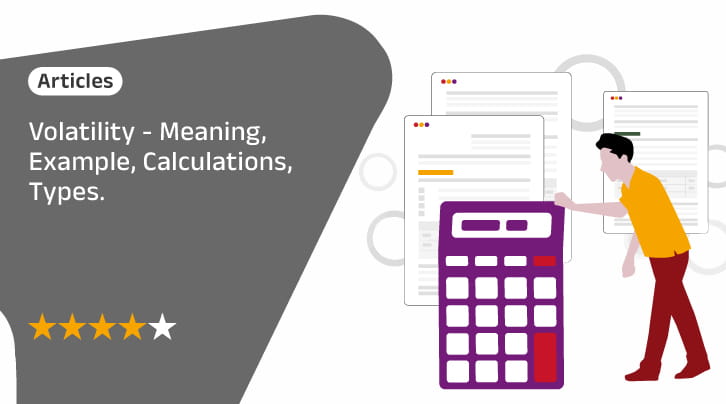The stock market is characterized by constant fluctuations - share prices rhythmically rise and fall over time. As investors, these price movements directly impact the value of our portfolios. But what exactly causes the unpredictable ups and downs of the market? Clarifying the drivers behind this volatility is key to navigating investment decisions.
This article will explore the meaning of volatility in financial contexts, its different types, and more.
What is Volatility?
Volatility is a degree of variation in the price of a security over a period of time. Volatility measures the level of risk associated with the fluctuating price of a security by computing standard variation of the annual returns. When discussing volatility in the stock market, we want to know the actual cost of assets or securities that offer excellent returns over time. This means if there's high volatility, the prices increase. On the flip side, low volatility means the prices stay more steady.
Factors like economic news, world events, or people's feelings about investing can make markets more or less volatile. Investors need to understand volatility to manage their risks and make informed decisions.
Types of Volatility
Volatility in financial markets has two main types: historical and implied.
Historical Volatility
Historical volatility in the market, also known as statistical volatility, looks at the past to understand how much the price of a stock has changed over a particular period.
Traders or investors use this data to estimate potential future volatility and make informed decisions based on the market's past behaviour. If a stock has a history of large price swings, it suggests higher historical volatility.
Implied Volatility
Implied volatility or projected volatility is all about expectations for the future. It's derived from the prices of options, which are contracts giving the right to purchase or sell an asset at a set price. If option prices are high, traders expect more significant price swings in the future.
In contrast, low implied volatility suggests the anticipation of more stable prices. It's like gauging how exciting the upcoming roller coaster ride is expected to be based on the ticket prices. Traders use implied volatility to make decisions about potential future market movements.
How to Calculate Volatility?
Volatility in the market is calculated using standard deviation and variance. As you know, volatility mentions changes with time, which takes the standard deviation and multiplies it by the square root of the number of periods.
vol = σ√T
In this,
v= volatility over some interval of time
σ= standard deviation of total returns
T= Total number of periods in the particular time horizon
What are the Factors Affecting Volatility?
Economic Indicators
Economic information like employment figures, GDP growth, and inflation rates, play a significant role in market volatility. Negative or Positive surprises can lead to increased uncertainty and volatility. For instance, a higher-than-expected unemployment rate may trigger market fluctuations as investors reassess economic conditions.
Geopolitical Events
International conflicts, political instability, or major geopolitical events can greatly impact market volatility. News related to trade tensions, elections, or diplomatic issues may create uncertainty, causing investors to adjust their positions rapidly. Geopolitical uncertainty often leads to heightened market reactions and increased volatility.
Market Sentiment
Investor emotions, collectively known as market sentiment, can heavily influence volatility. Fear, greed, and uncertainty can drive abrupt changes in buying and selling patterns. Sudden shifts in sentiment, such as a wave of optimism or a spike in fear, can lead to increased market volatility as traders respond to changing perceptions.
Interest Rates
Reserve banks' decisions regarding the rate of interest can cause a great impact on market volatility. This means any changes in interest rates influence investment decisions, borrowing costs, and overall economic activity. Unexpected adjustments in interest rates or signals from central banks about future policy changes can trigger market movements and contribute to volatility.
Company Earnings and News
The performance and news related to individual companies can significantly affect volatility. Earnings reports, product launches, legal issues, or management changes can lead to sharp price movements. Positive or negative news about a specific company can create ripples throughout the broader market, influencing overall volatility.
Different Measures of Volatility
Volatility Index
The VIX, often called the "fear gauge," is like a thermometer for the stock market. It measures how much traders expect the market to swing in the future. If the VIX is high, people are nervous and expect more ups and downs. If it's low, things are expected to be calmer. Imagine it as a gauge on a roller coaster predicting how thrilling the ride will be – higher readings mean a more exciting journey.
Beta
Beta is like a measure of how much a particular stock moves compared to the market. This means 1 shows the stock moving with the market, like a dance partner following every step. A beta above 1 suggests the stock is more volatile than the market, dancing with bigger moves. A beta below 1 indicates a steadier stock, moving less than the market. Picture it as a dance floor – some partners are twirling more than others, and beta helps us understand that dance.
The Bottom Line
Market volatility is a natural and unavoidable aspect of investing. It's essential to embrace it rather than fear it. By understanding the factors that contribute to volatility and implementing smart investment strategies, traders can easily navigate all the ups and downs of the stock market with greater confidence. Remember, the key is not to eliminate volatility but to manage it wisely to achieve financial goals.
Mutual Fund investments are subject to market risks, read all scheme related documents carefully.





 1800-270-7000
1800-270-7000




